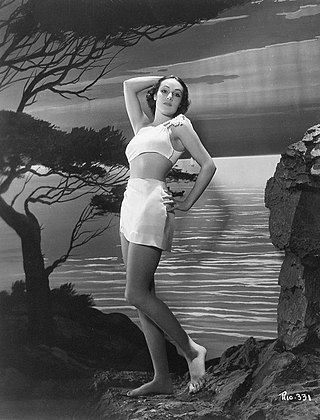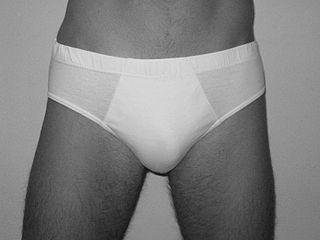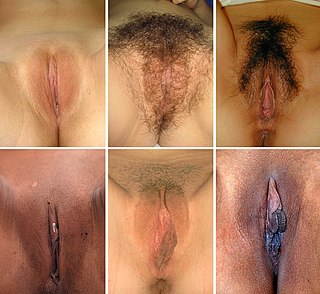
A bikini is a two-piece swimsuit primarily worn by women that features one piece on top that covers the breasts, and a second piece on the bottom: the front covering the pelvis but usually exposing the navel, and the back generally covering the intergluteal cleft and some or all of the buttocks. The size of the top and bottom can vary, from bikinis that offer full coverage of the breasts, pelvis, and buttocks, to more revealing designs with a thong or G-string bottom that covers only the mons pubis, but exposes the buttocks, and a top that covers only the areolae. Bikini bottoms covering about half the buttocks may be described as "Brazilian-cut".

The labia minora, also known as the inner labia, inner lips, or nymphae, are two flaps of skin that are part of the primate vulva, extending outwards from the inner vaginal and urethral openings to encompass the vestibule. At the glans clitoris, each labium splits, above forming the clitoral hood, and below the frenulum of the clitoris. At the bottom, the labia meet at the labial commissure. The labia minora vary widely in size, color and shape from individual to individual.

A swimsuit is an item of clothing designed to be worn by people engaging in a water-based activity or water sports, such as swimming, diving and surfing, or sun-orientated activities, such as sun bathing. Different types may be worn by men, women, and children. A swimsuit can be described by various names, some of which are used only in particular locations or for particular types of suit, including swimwear, bathing suit, bathing attire, swimming costume, bathing costume, swimming suit, swimmers, swimming togs, bathers, cossie, or swimming trunks, besides others.

Clogs are a type of footwear that has a thick, rigid sole typically made of wood, although in American English, shoes with rigid soles made of other materials are also called clogs.

In humans, the crotch is the bottom of the pelvis and is the part of the body that includes the groin and genitals.

Bikini waxing is the removal of pubic hair using a special wax, which can be hot or cold, that adheres to hairs and pulls them out when the wax is removed quickly from the skin, usually with a cloth strip. While the practice is mainly associated with women, male waxing has become a more common practice to remove men's pubic hair.

A tutu is a dress worn as a costume in a classical ballet performance, often with attached bodice. It may be made of tarlatan, muslin, silk, tulle, gauze, or nylon. Modern tutus have two basic types: the Romantic tutu is soft and bell-shaped, reaching the calf or ankle; the Classical tutu is short and stiff, projecting horizontally from the waist and hip.

Winklepickers or winkle pickers are a style of shoe or boot worn from the 1950s onward, especially popular with British rock and roll fans such as Teddy Boys. The feature that gives both the boot and shoe their name is the very sharp and long pointed toe, reminiscent of medieval poulaines and approximately the same as the long pointed toes on some women's high-fashion shoes and boots in the 2000s. They are still popular in the goth, raggare and rockabilly subcultures.

Pasties are patches that cover a person's nipples and areolae, typically self-adhesive or affixed with adhesive. They are usually worn in pairs. They originated as part of burlesque shows, allowing dancers to perform fully topless without exposing the nipples in order to provide a commercial form of bare-breasted entertainment. Pasties are also, at times, used while sunbathing, worn by strippers and showgirls, or as a form of protest during women's rights events such as Go Topless Day. In some cases this is to avoid potential prosecution under indecency laws.

The labia are the major externally visible structures of the vulva. In humans and other primates, there are two pairs of labia: the labia majora are large and thick folds of skin that cover the vulva's other parts, while the labia minora are the folds of skin between the outer labia that surround and protect the urethral and vaginal openings, as well as the glans clitoris.

A tan line is a visually clear division on the human skin between an area of pronounced comparative paleness relative to other areas that have been suntanned by exposure to ultraviolet (UV) radiation or by sunless tanning. The source of the radiation may be the sun or artificial UV sources such as tanning lamps. Tan lines are usually an unintentional result of a work environment or recreational activities, but are sometimes intentional. Many people seek to avoid tan lines that will be visible when regular clothes are worn.

Poulaines, also known by other names, were a style of unisex footwear with extremely long toes that were fashionable in Europe at various times in the Middle Ages. The poulaine proper was a shoe or boot of soft material whose elongated toe frequently required filling to maintain its shape. The chief vogue for poulaines spread across Europe from medieval Poland in the mid-14th century and spread across Europe, reaching upper-class England with the 1382 marriage of Richard II to Anne of Bohemia and remaining popular through most of the 15th century. Sturdier forms were used as overshoes and the sabatons of the era's armor were often done in poulaine style.

A burkini is a style of swimsuit for women. The suit covers the whole body except the face, the hands, and the feet, while being light enough for swimming. This type of swimwear was designed with the intention of creating swimwear for Muslims who observe hijab in this way. The amount of skin covered is about the same as the person wearing a full body wetsuit and a swimming cap.

Underwear, underclothing, or undergarments are items of clothing worn beneath outer clothes, usually in direct contact with the skin, although they may comprise more than a single layer. They serve to keep outer clothing from being soiled or damaged by bodily excretions, to lessen the friction of outerwear against the skin, to shape the body, and to provide concealment or support for parts of it. In cold weather, long underwear is sometimes worn to provide additional warmth. Special types of undergarments have religious significance. Some items of clothing are designed as undergarments, while others, such as T-shirts and certain types of shorts, are appropriate both as underwear and outerwear. If made of suitable material or textile, some underwear can serve as nightwear or swimwear, and some undergarments are intended for sexual attraction or visual appeal.

Many stylistic variations of the bikini have been created. A regular bikini is a two-piece swimsuit that together covers the wearer's crotch, buttocks, and breasts. Some bikini designs cover larger portions of the wearer's body while other designs provide minimal coverage. Topless variants are still sometimes considered bikinis, although they are technically not a two-piece swimsuit.

The thong is a garment generally used as either underwear or in some countries, as a swimsuit. It may also be worn for traditional ceremonies or competitions.

In clothing design, a panty line on a human body goes at an angle from the high hip down to the crotch. It is used as a reference line, for example, a babydoll can end either below or above the panty line. The term is also used for the edge of the panties, in particular when it is visible through the outer garment.

In mammals, the vulva comprises mostly external, visible structures of the female genitalia leading into the interior of the female reproductive tract. For humans, it includes the mons pubis, labia majora, labia minora, clitoris, vestibule, urinary meatus, vaginal introitus, hymen, and openings of the vestibular glands. The folds of the outer and inner labia provide a double layer of protection for the vagina. Pelvic floor muscles support the structures of the vulva. Other muscles of the urogenital triangle also give support.

Wearing underwear as outerwear is a fashion trend popularized by celebrities, sports and media. It began as a practical and comfortable variation of clothing, such as the T-shirt and the sleeveless shirt, but later evolved into provocative, controversial fashion statements. 21st century versions include the display of thongs and bras in women's clothing, and the display of underpants under low-slung pants in men. Wearing underwear as outerwear has historical antecedents in the display of undergarments in the sixteenth and seventeenth centuries.

A muffin top is a slang term typically used to describe a person's body fat that extends horizontally over the edges of the waistline of tightly fitting pants or skirts, visible when there is a gap between the upper and lower garment. The term is a reference to the way a muffin appears when it has been baked in a muffin tin, so that the top of the muffin extends horizontally over and around the top of the tin or casing.





















